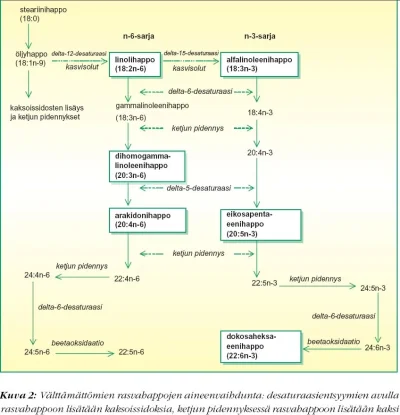Tulee pitkähkö posti mutta koetan lyhennellä lainauksia ja boldata olennaisen laiskoille

"higher-fat diets appear to maintain circulating testosterone concentrations
better than low-fat diets/.../Generally, it is recommended that athletes consume a moderate amount of fat (approximately 30% of their daily caloric intake), while increases up to <B>50% of kcal can be safely ingested by athletes during regular high-volume training</B>"
Lähde: ISSN Exercise & Sport Nutrition Review: Research & Recommendations, Kreider ja kumppanit.
"<B>Mean plasma concentrations of total and sex-hormone-binding-globulin (SHBG)-bound testosterone were 13% and 15% higher, respectively, on the high-fat, low-fiber diet </B>and the difference from the low-fat, high-fiber diet was significant for the SHBG-bound fraction (P = 0.04). Men's daily urinary excretion of testosterone also was 13% higher with the high-fat, low- fiber diet than with the low-fat, high-fiber diet"
<a href="http://www.ajcn.org/cgi/content/abstract/64/6/850" TARGET="_BLANK">Lähde</a>
"When men were transferred from their customary diet to an experimental diet, which contained <B>less fat</B> with a higher polyunsaturated/saturated ratio (P/S-ratio) and more fibre, there was a significant decrease in serum total testosterone concentrations/.../ Furthermore, serum free, unbound <B>testosterone fell</B>"
<a href="http://www.ncbi.nlm.nih.gov/entrez/query.fcgi?cmd=Retrieve&db=PubMed&list_uids=6298507&dopt=Abstract" TARGET="_BLANK">Lähde</a>
"After consuming a diet with a high fat content (greater than 100 g fat/day) for two weeks, the mean plasma cholesterol level increased (p less than 0.02) while the mean SHBG level decreased (p less than 0.02). Changing the diet from one with a high fat to <B>low fat</B> content (less than 20 g fat/day) for a further two week period resulted in a significant reduction in mean plasma cholesterol level (p less than 0.001) while the mean SHBG level increased (p less than 0.01). <B>The increase in plasma SHBG was associated with a significant decrease in the free testosterone fraction and free testosterone concentration.</B>"
Tuo boldattu kohta on aika mielenkiintoinen!
<a href="http://jcem.endojournals.org/cgi/content/abstract/64/5/1083" TARGET="_BLANK">Lähde</a>
"Our results indicate that in men a <B>decrease in dietary fat content and an increase in the degree of unsaturation of fatty acids reduces the serum concentrations of androstenedione, testosterone and free testosterone</B>"
<a href="http://www.ncbi.nlm.nih.gov/entrez/query.fcgi?cmd=retrieve&db=pubmed&list_uids=6538617&dopt=Abstract" TARGET="_BLANK">Lähde</a>
"Our results demonstrated that dietary protein, fat, SFA, MUFA, PUFA/SFA ratio, and protein-to-carbohydrate ratio were all significantly correlated with preexercise T concentrations/.../ These data are consistent with the findings of several other investigations that have reported a <B>decrease in T in individuals consuming a diet containing ~20% fat compared with a diet containing ~40% fat</B>. Vegetarians also consume less fat, SFA, and a higher PUFA/SFA ratio compared with omnivores, and vegetarians exhibit lower concentrations of T compared with omnivores "
Samasta lähteestä:
"Tegelman et al. observed a significant <B>positive correlation (r = 0.76) between percent energy fat and T in young athletic men</B>, which is very similar to the correlation (r = 0.72) obtained in this study. Also, Adlercreutz et al. reported significant positive correlations between T and dietary fat, SFA, MUFA, and cholesterol in postmenopausal women. The same nutrients were positively correlated with T in the present investigation except for cholesterol, which showed a correlation of r = 0.53 (P = 0.07) with T. <B>In contrast to the results obtained in this study, Key et al. reported a significant positive correlation (r = 0.37) between PUFA and T in male vegetarians and omnivores</B>. Our results showed a nonsignificant correlation between PUFA and T and a significant negative correlation between the PUFA/SFA ratio and T."
<a href="http://jap.physiology.org/cgi/reprint/82/1/49.pdf" TARGET="_BLANK">Lähde</a>
Liittyen hiilareihin ja proteiiniin:
"<B>Testosterone concentrations in seven normal men were consistently higher after ten days on a high carbohydrate diet</B> (468 +/- 34 ng/dl, mean +/- S.E.) than during a high protein diet (371 +/- 23 ng/dl, p less than 0.05) and were accompanied by parallel changes in sex hormone binding globulin (32.5 +/- 2.8 nmol/l vs. 23.4 +/- 1.6 nmol/l respectively, p less than 0.01). By contrast, cortisol concentrations were consistently lower during the high carbohydrate diet than during the high protein diet"
<a href="http://www.ncbi.nlm.nih.gov/entrez/query.fcgi?cmd=retrieve&db=pubmed&list_uids=3573976&dopt=Abstract" TARGET="_BLANK">Lähde</a>
Joidenkin mielestä taas rasvalla ei ole niin suurta merkitystä:
"The dietary components that correlated best with SHBG levels were protein and fiber. Protein intake, which is marginally significant when tested by simple correlation, is more strongly significant when tested using multiple regression. Thus, <B>the lower the protein intake, the higher the concentration of SHBG</B>. /.../One of the major controlling factors on SHBG synthesis is insulin. This intake of protein has been shown to increase insulin levels, and <B>insulin has been shown to reduce SHBG levels</B>. The effect of protein on SHBG could be mediated in part by its effect on insulin, with a low protein intake leading to low insulin levels and release of the inhibition of SHBG synthesis. If this were to be the mechanism by which protein effects SHBG levels, one would expect that carbohydrate (CHO) intake, a stimulus for insulin release, would also effect SHBG levels. However, <B>we could find no significant relationship between CHO intake and SHBG levels</B> when tested by simple correlation or controlling for other factors. Therefore, it is likely that the relationship of protein intake to SHBG levels involves more than a possible effect on insulin"
<a href="http://jcem.endojournals.org/cgi/content/full/85/1/293" TARGET="_BLANK">Lähde</a>
Näilläkään ei rasva vaikuttanut SHBG:hen:
"The intakes of calories, fat (animal or vegetable), and carbohydrate were not related to SHBG concentration. We conclude that age and body mass index are major determinants of SHBG concentrations in older men, and <B>fiber and protein intake are also significant contributors to SHBG levels, but total caloric intake and the intake of carbohydrate or fat are not significant.</B>"
<a href="http://jcem.endojournals.org/cgi/content/abstract/85/1/293" TARGET="_BLANK">Lähde</a>
Akuutti vaikutus:
"This is the first documentation, to our knowledge, of the acute effect of a fat-containing meal on sex steroid concentrations in blood. Our observations suggest that a <B>fat-containing meal reduces testosterone concentrations</B> without affecting luteinizing hormone. This might indicate that fatty acids modulate testosterone production by the testes"
<a href="http://www.ncbi.nlm.nih.gov/entrez/query.fcgi?cmd=Retrieve&db=pubmed&dopt=Abstract&list_uids=2392062" TARGET="_BLANK">Lähde</a>
Ristiriitaisia tuloksia löytyy kuten aina, mutta kyllä suositus 30E% rasvasta on aika hyvä. Ehkä jopa enemmästä voisi olla hyötyä. Tyydyttynyttä rasvaa kartetaan aika paljon, mutta kyllä sitäkin pitää syödä (ainakin testotasoja ajatellen). Ajatuksia?






